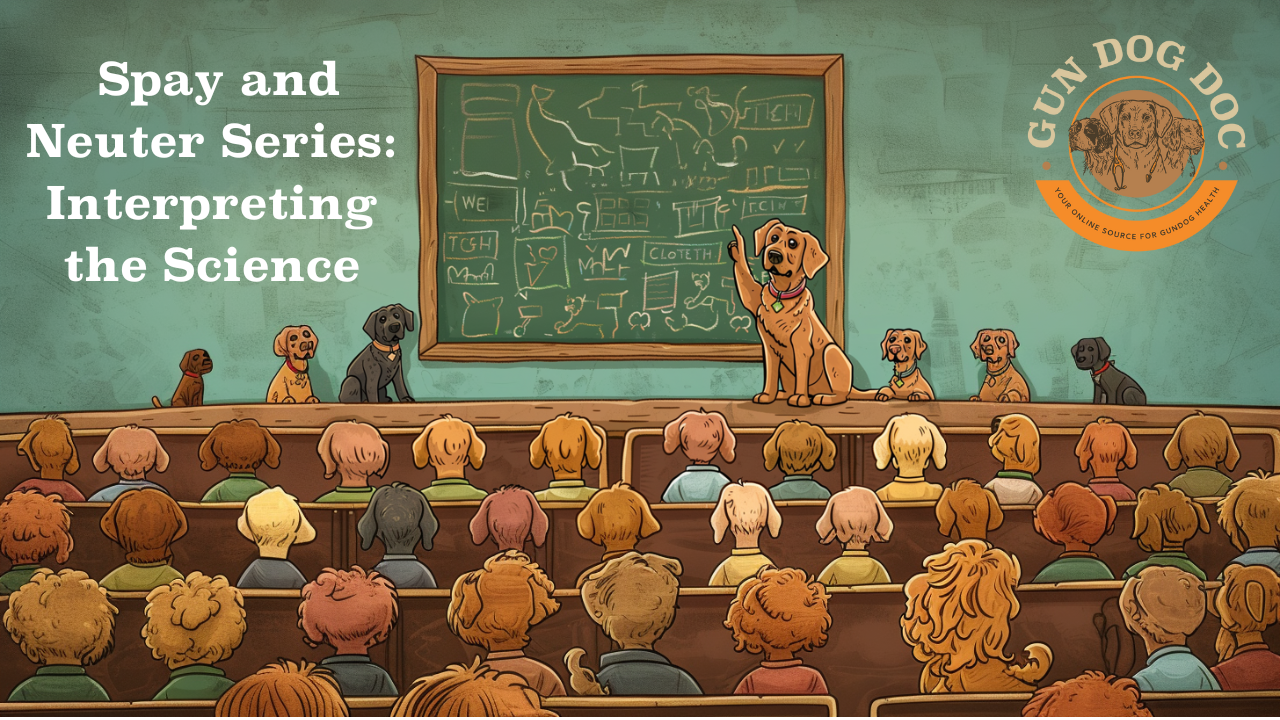Starting this series on spaying and neutering, we need to first address how we arrived at a point where there’s so much confusion around this topic. To understand the current debate, it’s crucial to look at the historical recommendations made by veterinarians and the education veterinarians have received over generations that have influenced and shaped those recommendations.
Historically, many clinics have made blanket recommendations, such as spaying and neutering all dogs at 4-6 months of age. These recommendations were made with the best intentions for pets and their owners. However, in the last decade, especially the past five years, new research has emerged, challenging these long-held beliefs. Unfortunately, with any long-held beliefs and behaviors it takes time for the old ways of doing things to be undone. When engrained beliefs and behaviors are challenged it is often met with skepticism from the establishment, no matter the subject matter.
Historical Influences on Spaying and Neutering Recommendations
Four main categories have traditionally influenced the recommendation to spay and neuter dogs, particularly at an early age:
- Pet Overpopulation
- Elimination of Behavioral Issues
- Decreasing the Risk of Serious Medical Conditions
- Owner Preference Against Having an Intact Animal
Pet Overpopulation
Preventing pet overpopulation has always been a key reason for spaying and neutering. Even outside of the veterinary profession, figures like Bob Barker from “The Price is Right” have urged pet owners to spay and neuter their pets to control the population for decades. Drew Carey continues this plea today.
While neutering and spaying prevent additional litters, the primary contributors to overpopulation are often not responsible pet owners or breeders. Studies show that only a small percentage of shelter dogs are purebreds. In my experience, responsible breeders and pet owners who have accidental litters typically place the puppies in good homes with rigorous scrutiny and all of them have taken puppies back that didn’t work out in their first homes.
The sad reality is that overpopulation issues often stem from people who either lack the resources or the concern to seek adequate veterinary care. Spaying and neutering dogs under routine veterinary care likely won’t make a significant dent in overpopulation because these dogs are not the primary contributors.
This becomes even more problematic for those of us with purpose-bred dogs. It might sound like a fanciful idea that we all could just stop buying purebreds and adopt from the endless supply of shelter dogs. The reality is that while many of those dogs may make wonderful companions there are very, very few that will be retrieving late-season mallards or pinning a covey of grouse on the prairie.
While it may seem noble to advocate for spaying and neutering to help control the pet population that argument just doesn’t carry the weight it once did with how responsible dog owners care for and house their dogs.
Behavioral Issues
Another reason for spaying and neutering has been to eliminate problematic behaviors like aggression, wandering, and mounting. Many canine behavior textbooks recommend spaying or neutering to address these issues, attributing behavioral changes to reduced testosterone levels.
Here again this train of thought seems logical and for most of my career I believed in this logic and promoted it to many clients. As it relates to male dogs specifically this is typically directed towards intermale aggression, marking and mounting behaviors. I’ll confess it was this same logic that I used when I made the decision to neuter Boomer later in life. He had started marking more and wouldn’t tolerate my hunting buddy’s male dog if the dog got overly rambunctious. When we look at the studies, though, we now know that when neutering is performed after six months of age it proves to be completely ineffective.
Now, this is a statistical thing, and it doesn’t mean there aren’t cases that it would have an effect, but in general it is not effective. Ironically, I felt like with Boomer the areas I had concerns with improved. Now I question if I fell victim to selection bias and that I actually was aware of the behaviors and changed my interactions with him and they were corrected via training rather than neutering. When we take a look at the pros and cons of spaying and neutering in future videos we will talk about some studies that have actually shown a negative behavior change with these procedures in some breeds.
In future posts, we’ll explore studies showing that spaying and neutering can sometimes lead to negative behavioral changes in certain breeds.
Medical Conditions
The veterinary profession has long advocated for spaying and neutering to reduce the risk of serious medical conditions. For females, these procedures are said to lower the risk of pyometra (a life-threatening uterine infection) and mammary cancer. For males, the focus has been on preventing testicular and prostate diseases.
Our previous discussions revealed that neutering is actually associated with an increased risk of prostate cancer in males though it will eliminate benign prostatic hyperplasia and prostatitis. For females, while spaying nearly eliminates the risk of pyometra, the discussion around mammary cancer is more nuanced. Historical data from a 1969 study suggested that spaying before the first heat reduces the risk of mammary cancer. However, the actual interpretation of this data has been somewhat skewed over the years.
Subsequent studies, particularly from Europe, where spaying and neutering are less common, question the overall risk of mammary tumors. Furthermore, the increased risk of certain cancers in some breeds associated with spaying and neutering necessitates a more detailed conversation about these procedures. I will stress here, and several times in upcoming posts, not all breeds show the same increased risk for cancer, and this certainly is not the end all blanket statement that you shouldn’t spay or neuter. I’m intending this series to provide all the available information to allow people to make informed decision on current information.
Owner Preference Against Having an Intact Animal
This category is self-explanatory, and I don’t think it needs extensive discussion. With male dogs this usually centers around marking, aggression and hyper-sexuality. Intact female dogs typically cycle two times a year and can have bleeding and discharge for nearly a month each cycle which I can attest is problematic to deal with. While this point is pretty straightforward I also think it is one of the most individualized parts of the discussion and one that internet experts don’t take into account when giving their recommendations.
Moving Forward
In upcoming posts, we will delve deeper into the long-term health effects of spaying and neutering, including joint disorders, cancer, and lifespan. We’ll explore breed-specific information and broader knowledge to help you make informed decisions based on the latest science.
As I was preparing this series I came across content from Dr. Bruce Christensen of Kokopelli Veterinary Center, you can look him up at the website (https://kokopellivet.net/team-member/bruce-w-christensen-dvm-ms-dact/) or follow them on Instagram (https://www.instagram.com/kokopellidvm/). If you are serious about breeding or just want to learn more on this subject I would highly encourage you give their content a follow. They also have some on-demand webinars available at their site. I have not watched any of the webinars but the one continuing education lecture I did see I was very much blown away by Dr. Christensen’s approach, knowledge and delivery.
Next week, we will take a closer look at the long-term health effects of spaying and neutering, focusing on specific breeds and general knowledge.



